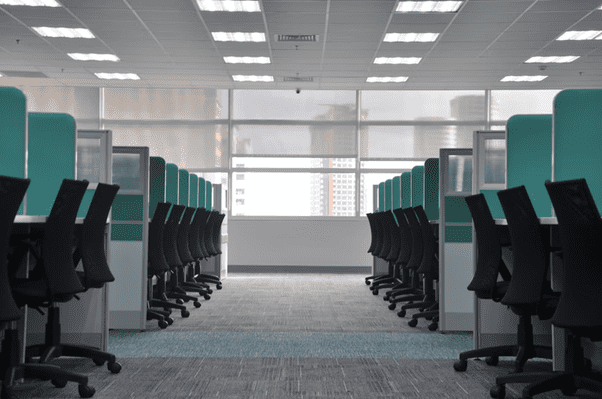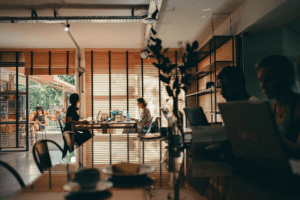
A chronotopic approach to rescuing office buildings
3 minutes of reading
in partnership with


Working from home, staggered hours and coworking which were already budding trends are now widely accepted after several lockdowns. As a result, traditional office space is largely deserted. All this vacant and under-occupied space needs to be reworked to accommodate new working practices which have been dramatically transformed by the health crisis and the digital revolution.

New approaches are emerging to address the issue. They include consideration for temporal norms, versatility and modular spaces that adapt to flexible needs depending on the time, day, week or year. This new approach to diversifying office use is probably the most agile solution for commercial property in the future.


 Tristan Gassert on Unsplash
Tristan Gassert on Unsplash
The emergence of working from home.
Workplaces are undergoing changes due to a four-pronged revolution: economic, digital, social and regional. Better internet connections combined with more mobile digital services, plus changes in attitude to work in recent years have triggered far-reaching transformations, including working from home. Digital innovations have development in step with this rising need in communication techniques. New videoconferencing applications and the improvement of increasingly efficient internet connections are more conducive to working from home. This trend has been the subject of various studies which show working from home reduces fatigue and anxiety. As a result, working hours have become more flexible, adapting to constraints. Other advantages are less driving and transport, which are generally a major source of stress. Teleworking became a norm in Europe in 2002 with a framework agreement. It provides regulations to ensure functional conditions and encourages the development of working from home so that “flexibility and security go hand in hand, and job quality is enhanced”. In France, the Macron decree, dated 22 September 2017, recognises teleworking as an accepted working method. This concept has also developed more recently due to the awareness of ecological issues and indirect benefits for the environment. Over 70% of French people use their cars to get to work. Limiting their daily journeys would significantly reduce each person’s carbon footprint. However, some practices required for remote working do not completely neutralise the carbon balance. For example, practices such as videoconferencing generates quantities, albeit small, of greenhouse gases via the consumption of data from the Wi-Fi or cellular network. The increase and generalisation of working from home one or more days per week when the job permits represents a significant improvement in the quality of life for urban dwellers. This practice which had been progressing for years has grown exponentially since 2020. With the COVID-19 crisis, teleworking became mainstream. It is now an expectation in the job market, particularly for intellectual jobs and the service industry, using collective office spaces in big cities.
Teleworking: what are the consequences for our cities?
The sudden development of teleworking has caused a major shift in cities which now see occupancy of office buildings waning. “Traditional offices spaces are only occupied 50% to 70% of the time.” This drop in the working population in now under-occupied spaces also has many negative effects on the surrounding urban environment. This is most felt in a reduced flow of customers for local businesses and a decrease in property values. The impact of this trend is heightened by many other urban changes that were already at work before the pandemic: multiple crises (social, environmental, migration and housing), regulations and new practices for the environment and to limit construction (reducing artificial surfaces, decarbonisation, recycling and renovating existing buildings), with land scarcity and price increases. Leaving buildings unused or partially vacant is unthinkable in light of current issues and economic models. Urban actors are seeking short- and long-term solutions for reusing offices. This has led to the development of coworking spaces and third places which provide alternatives to the working population who want to separate work and home life and avoid the isolation of teleworking. However, these innovative solutions are not sufficient for addressing global issues raised by the vacancy of commercial property in urban centres in the long term. Methods feebly attempted in the past are now becoming necessary. The concept of multiple use of the same space is making progress. A chronotopic approach to cities and buildings that takes into account space and time is required. This theory is already at work in the “quarter-hour city” which requires that all necessary amenities be accessible to city dwellers within a limited space that is accessible to all. This method optimises maximum use of the same space for flexibility over time.
How does the chronotopic approach work?
“Understanding time […] is essential for understanding and managing societies and an important collective challenge for people, organisations and regions. The notion of time is inherent to the concept of sustainable development which requires that the needs of the present do not compromise the future. Yet time – unlike energy and space – has been insufficiently addressed as a key element for organisation and action in the way cities and regions have developed.” Urban actors must rethink how they design and manage cities, taking into account both flows and timetables to create more humane and accessible cities with better quality of life. A temporal approach to urban planning tools considering urban and social issues, combined with reflection on versatile and modular spaces, seems to be a sustainable solution for the future. This approach reduces the consumption of space and energy while optimising urban concentration and social links. Three hybrid options optimise the use of space. Firstly, pooling. This is when the same space is used for the same purpose by different users. The different users complement each other temporally. For example, making a coworking space available to students in the evening and on weekends. Secondly, hybrid use. The same space can be used for different purposes. The Heldergroen studio in the Netherlands is the perfect illustration of this concept with desks in open spaces that “disappear at 6pm sharp, […] lifted, as if by magic, by steel cables, and lodged in clever false ceilings. The workspace is completely available to be transformed for other uses, such as a gym class, as a conference venue , or as a dance floor.” The third and last temporal tool blends the first two options: pooling hybrid spaces. Full optimisation of the chronotopic approach mixes uses, users and temporal organisation. Recently, Les Bureaux des Coeurs association developed this tool by allowing homeless people to use offices in the evening and on weekends when employees have gone home. The Housing First approach helps the homeless focus on getting back to work and reintegrating society. The chronotopic approach responds to such societal issues that are currently of major importance in France. Pooling and hybrid uses are already being considered in the development of new constructions. It is also one of the key themes of the Reinventing Paris programme which presented the construction of a building designed for alternative uses depending on the time of day or week: “Le Chronotope in the 13th district of Paris”. Le Chronotope is designed to accommodate “the new temporal aspects of modern urban life: a city that works, does business and shops, sleeps, has fun, educates and creates…” Tristan Gassert on Unsplash
Tristan Gassert on Unsplash
Can the chronotopic approach save office buildings?
Given current transformations that are affecting traditional urban rhythms, it seems essential to consider the spatiotemporal diversity that sets the pace in urban spaces. Sustainable solutions are required to address social, economic and environmental challenges, particularly for land use. This approach could also respond to the homeless crisis by temporarily transforming offices into housing. If the chronotopic approach is to be integrated into urban planning and respond to changing needs and lifestyles, property must be designed, before construction, to anticipate and change, to be agile regarding access, spaces, common areas, and even facades and openings. Exploring reversible construction methods is vital. The goal is to make buildings more adaptable over time so their purpose can be changed, from offices into housing, for example. Intensifying use throughout the country is not the goal. The chronotopic approach provides solutions for future urban spaces, but it is important to leave space in cities. Urban dwellers need room to take time out and breathe in well-ventilated areas that are already surrounded by dense urbanism. Reworking office buildings so they adapt to uses, temporal needs and current issues has high potential benefits for cities and their residents. Changes and measures using the chronotopic approach are leading to public policies for urban rehabilitation and construction. This creates potential for the construction of cities more consistent with current changes in needs and uses in the medium term. These developments also respond to environmental challenges and the objectives of living together more harmoniously and improving our living environment.More reading
Read also




What lies ahead? 7 megatrends and their influence on construction, real estate and urban development
Article
20 minutes of reading

